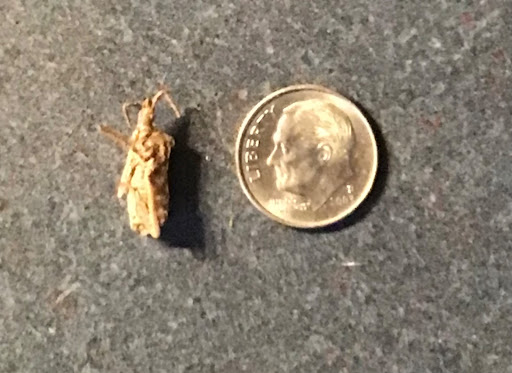‘Whatever You Do, Do Not Squish Them’
The Origins, the Spread, the Effect, and the Prevention of an Invasive Species

A dried up deceased stink bug found in a windowsill, dime for comparison (Doucot photo)
They stowed away on ships to get here, they invaded our homes, and they’re damaging our crops. It’s in the name, they stink.
Brown marmorated stink bugs are a true bug species that are native to East Asian countries such as China and Japan. The bugs are characterized by their odor, which many compare to cilantro, when threatened or injured through glands in their abdomen.
Not only do we find the bugs affecting our agriculture, we can’t escape them in our homes or in our school. Stink bugs end up finding their ways into buildings when temperatures drop by entering through cracks and entry points like windows.
Accidentally introduced to the United States through being present on cargo ships, the first documented stink bug specimen was collected in September 1998 in Alleytown, Pennsylvania, where it is believed to have first been introduced. As time went on, these bugs spread and became an invasive species. According to PBS.org, as of November 2011, brown marmorated stink bugs spread to 34 states, including Massachusetts.
Throughout the Eastern United States, the brown marmorated stink bug has been easily destroying crops. Apples, apricots, pears, cherries, corn, grapes, lima beans, peaches, peppers, tomatoes, and soybeans are just a lot of the many crops that they eat. Stink bugs puncture plant tissue with their stylets (piercing mouth) to get the plant juices that will serve as their nutrients. When this happens, the plant loses vital fluids, which can result in seed distortion, seed destruction, delayed plant maturation, and increased susceptibility to infections. Could you imagine eating a fruit during lunch that you don’t even realize is going to make you sick?
One doesn’t have to worry too much, however, as they are harmless insects. Outlooks of them at Triton vary. Senior Bryan Nichols is apathetic towars the insects. “Unless they’re on my bed, I really don’t care,” said Nichols
Senior and fellow staff writer, Emma LeBlanc, is one of many who deals with these pests in her home.
“They’re everywhere. My mom literally had to buy a vacuum just to suck them up.” said LeBlanc.
Vacuuming is one method of getting rid of them. Two anonymous exterminators from Freedom Pest Control in Merrimac, MA gave other ways to deal with them. “Whatever you do, do not squish them. We all know it isn’t pleasant. Seal up points of entry and set up insect traps.” said one exterminator. It is recommended that a basic repellent for stink bugs consists of hot water, dish soap, and white vinegar. “Kills them after a little bit,” the other said.
Stink bugs are just tiny foreign invaders that serve as nuisances rather than threats. After 20 years of spreading, they aren’t looking like they’re going to leave any time soon. They were inadvertently introduced to many ecosystems and they serve as a widespread pest to United States agriculture. It’s wishful thinking to be able to crack down on a species of common insects with wings but there are still certainly ways to keep them from stinking up your life too much.
According to StopBMSB.org, an anti-stink bug initiative, as of 2021, the brown marmorated stink bug species has been detected in 47 U.S. States and four Canadian provinces. Only 11 of the 47 states deal with these stink bugs as a severe agriculture problem. There’s really no telling what could become of this spread.

Hello! My name is Nick Doucot. I’m a senior at Triton High School and for this year I decided to take Journalism in order to contribute to the Triton...






